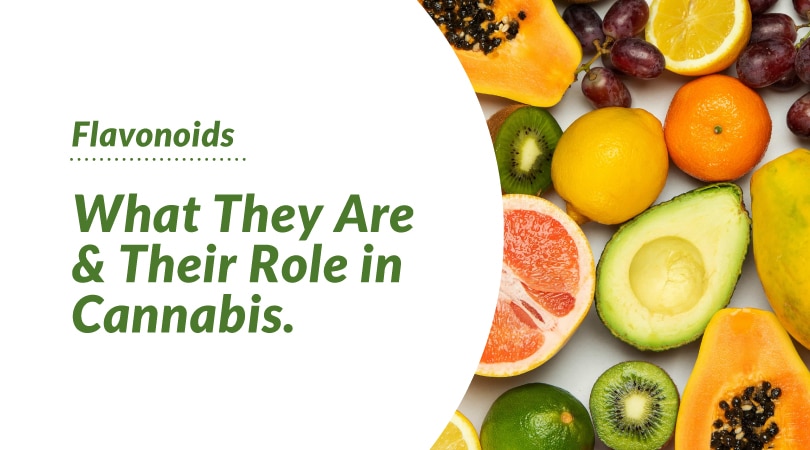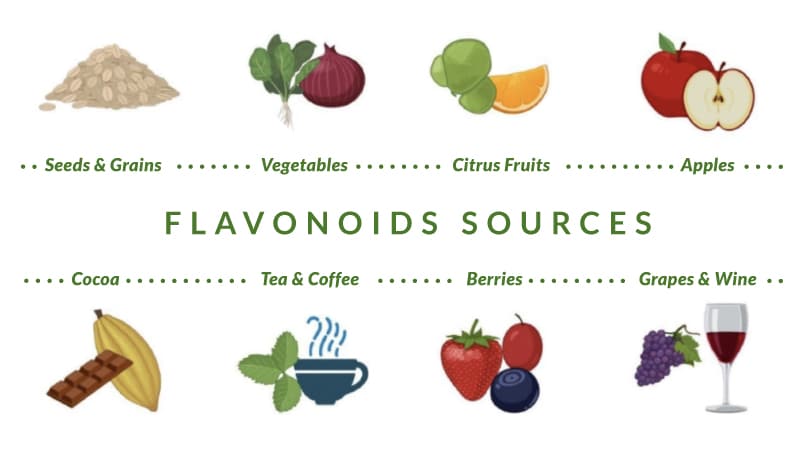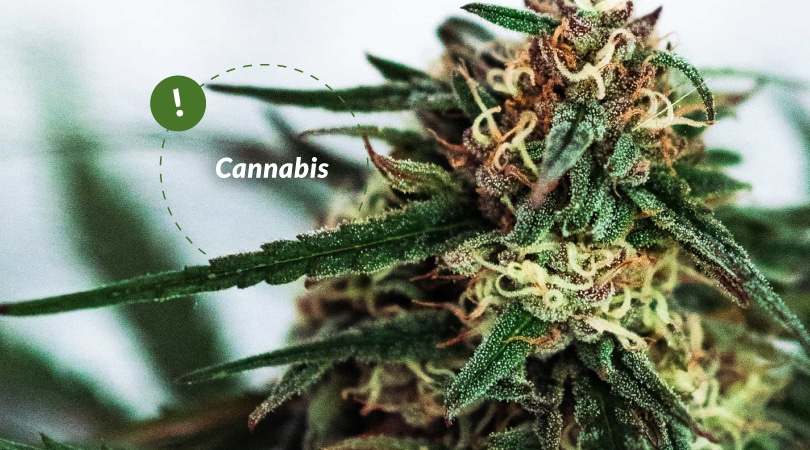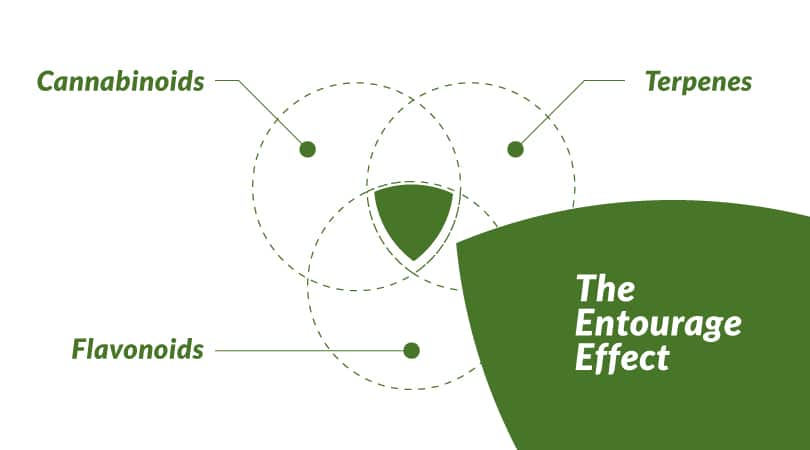
Flavonoids: What They Are & Their Role in Cannabis
Flavonoids: the not-so-secret compounds in plants that give different foods and products their unique characteristics. While all of us have tried something and loved (or hated) its flavor, we may not have considered the “why” behind it—until now.
While flavonoids are present in all plants, they’re commonly recognized for their role in cannabis. With scent and flavor being huge distinguishing factors in cannabis products, it’s no wonder why the substance responsible is a hot topic.
Keep reading to learn more about flavonoids’ role in plants and how they affect cannabis’ flavor profile and survival.
Understanding Flavonoids

What Are Flavonoids?
A 2016 study defines flavonoids as a group of natural substances with variable phenolic structures that are found in fruits, vegetables, grains, bark, roots, stems, flowers, tea, and wine. In other words, flavonoids are plant compounds that are connected to a variety of health benefits and play a big role in the characteristics of a plant.
On the other hand, a 2020 study describes flavonoid-rich foods as superfoods, which include tea, wine, leafy vegetables, onions, apples, cherries, soybeans, and citrus foods. Flavonoids are also recognized for their role in cannabis (we’ll discuss this more below).
Role of Flavonoids in Plants
Flavonoids are crucial to the survival and characteristics of a plant. These compounds are not only responsible for the color, flavor, and fragrance of a plant, but a recent study states that they perform many functions like regulating cell growth, attracting pollinator insects, and protecting against biotic and abiotic stresses.
Flavonoids in Cannabis

Importance of Flavonoids in the Cannabis Plant
Flavonoids perform important roles in the cannabis plant, such as:
- Defend cannabis against the sun’s rays and predators
- Attract bees, butterflies, and other pollinators to aid in reproduction
- Antioxidative properties
- Anti-inflammatory properties
While more research is needed, it’s believed that flavonoids’ beneficial properties could also contribute to cannabis’ famous therapeutic effects.
Prominent Flavonoids in Cannabis
A 2021 study states that more than 20 flavonoids have been identified in C. sativa, with the popular ones being flavone (apigenin and luteolin) and flavonol (kaempferol and quercetin) aglycones and glycosides.
How Flavonoids Affect Cannabis’ Color and Taste
Flavonoids in cannabis contribute to the range of colors seen in the plant. Flavonoids also contribute to the taste and aroma of cannabis by interacting with other compounds, such as terpenes. Terpenes are responsible for the distinctive scents associated with different strains of cannabis, and flavonoids can enhance or modify these aromas.
The combination of different flavonoids with other chemical compounds found in the plant contributes to the unique characteristics of cannabis, allowing the consumer to find strains that match the characteristics they prefer.
How Cannabis Flavonoids Work in the Body
Flavonoids play a role in how a plant is perceived, but they also work with cannabinoids and terpenes to interact with chemical receptors in the body’s endocannabinoid system. As we’ll discuss below, cannabis flavonoids have their own benefits that contribute to this crucial interaction.
And since every strain has different ratios of chemical compounds, different strains can trigger different reactions. For instance, some strains are ideal for pain relief, while others may help you focus.
The unique combination that strains contain means the results may differ. What they do have in common, though, is that the effects are a result of the interaction between the ECS and the chemical compounds found in the hemp plant.
Benefits of Flavonoids in Cannabis
Similar to food, flavonoids in cannabis have anti-inflammatory, antioxidant, and antibacterial properties. Although research is limited, it’s believed to also have potential neuroprotective effects, possibly lowering the risk of disorders, cardiovascular disease, and even cancer.
Flavonoids may be beneficial on their own, but it’s believed that they work best when combined with other compounds, referred to as the entourage effect.
The Entourage Effect

What Is the Entourage Effect?
The entourage effect is the idea that all hemp compounds work best when taken together, creating a natural “synergy.” A 2020 study explains this effect as “the suggested positive contribution derived from the addition of terpenes to cannabinoids.”
While this effect refers to all of the compounds in the plant working together, the three most prominent are cannabinoids, terpenes, and, you guessed it, flavonoids.
Cannabinoids, Terpenes, and Flavonoids: What’s the Difference?
Cannabinoids are naturally occurring compounds found in the cannabis plant. While there are more than 100 that are found in the plant, the most popular cannabinoids include THC, CBD, and CBG. When these compounds interact with the body’s endocannabinoid system, they help create a state of homeostasis.
Terpenes are compounds in plants that are responsible for the way they smell. With over 200 different types of terpenes in the hemp plant, there’s a lot of variety that comes with it. And while terpenes are recognized for their role in the aroma of a plant, they also contribute to its taste.
As mentioned, flavonoids are responsible for the color, flavor, and fragrance of a plant. Similar to terpenes, flavonoids are an important part of the plant’s growth and survival.
How the Entourage Effect Contributes to the Overall Effectiveness of Cannabis
While compounds may have benefits on their own, it’s believed that they can be amplified when consumed together. A 2011 review of studies found that taking terpenes and phytocannabinoids together may be beneficial for pain, anxiety, inflammation, epilepsy, cancer, and fungal infections.
That’s why products that contain all of the compounds of the plant, such as full-spectrum CBD oil, are often preferred over pure CBD. While more research is required, the entourage effect could offer consumers optimal results.
Takeaway
Flavonoids are responsible for the color, flavor, and fragrance of a plant, but they also aid in the plant’s survival. While flavonoids have been around since the beginning of time, many people have become interested in their role in cannabis.
Cannabis’ scent and flavor profile are two of its distinguishing qualities. And since there can be so many different combinations of chemical compounds in the plant, each cannabis product can have different characteristics such as color, taste, and effects.
The entourage effect suggests that the benefits of flavonoids and other compounds are enhanced when consumed together. The combination of flavonoids with other prominent compounds, such as terpenes and cannabinoids, aids in creating the pain-relieving and therapeutic effects that cannabis is recognized for.
To achieve the entourage effect and experience the benefits of flavonoids working in unison with other compounds, opt for full-spectrum products, such as our organic CBD oil and selection of CBD salves.
References
Bautista, J. L., Yu, S., & Tian, L. (2021, February 18). Flavonoids in cannabis sativa: Biosynthesis, bioactivities, and biotechnology. ACS omega. https://www.ncbi.nlm.nih.gov/pmc/articles/PMC7931196/#:~:text=More%20than%2020%20flavonoids%20have,and%20quercetin)
Dias, M. C., Pinto, D. C. G. A., & Silva, A. M. S. (2021, September 4). Plant flavonoids: Chemical characteristics and biological activity. Molecules (Basel, Switzerland). https://www.ncbi.nlm.nih.gov/pmc/articles/PMC8434187/#:~:text=Flavonoids%20are%20secondary%20metabolites%20that,and%20abiotic%20stresses%20%5B1%5D.
Ferber, S. G., Namdar, D., Hen-Shoval, D., Eger, G., Koltai, H., Shoval, G., Shbiro, L., & Weller, A. (2020). The “entourage effect”: Terpenes coupled with cannabinoids for the treatment of mood disorders and anxiety disorders. Current neuropharmacology. https://www.ncbi.nlm.nih.gov/pmc/articles/PMC7324885/
Panche, A. N., Diwan, A. D., & Chandra, S. R. (2016, December 29). Flavonoids: An overview. Journal of nutritional science. https://www.ncbi.nlm.nih.gov/pmc/articles/PMC5465813/
TAMING THC: Potential cannabis synergy and phytocannabinoidâ … – wiley. (n.d.). https://bpspubs.onlinelibrary.wiley.com/doi/epdf/10.1111/j.1476-5381.2011.01238.x
Waheed Janabi, A. H., Kamboh, A. A., Saeed, M., Xiaoyu, L., BiBi, J., Majeed, F., Naveed, M., Mughal, M. J., Korejo, N. A., Kamboh, R., Alagawany, M., & Lv, H. (2020, February). Flavonoid-Rich Foods (FRF): A promising nutraceutical approach against lifespan-shortening diseases. Iranian journal of basic medical sciences. https://www.ncbi.nlm.nih.gov/pmc/articles/PMC7211351/#:~:text=Tea%20and%20wine%20are%20the,flavonoids%20(34%2D36).
